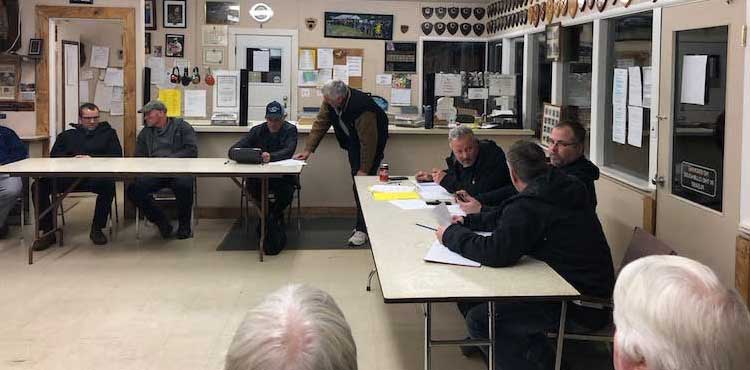

(L to R at head table) Deryk Krefting, (SFAC 17 Chair), Jarrod Pinder (SFAC 17 Co-Chair and Recording Secretary), Brad Beaith (South Coast Recreational Fisheries Coordinator)
by Joel Unickow & Pat Ahern
The average recreational fisherman may not realize they have a say in how our fisheries are managed. I’m hoping that you’ve taken interest in the process—an interest in being involved, and not just jumping to conclusions about what was discussed.
Whether it’s fishing, education, healthcare, housing, whales, or pipelines, some decisions are going to be made at the top by whatever government is currently in power, and you can bet your bottom dollar that they won’t please everyone. That’s just how it is. You can shake your fist at the sky as much as you like, but that won’t change the weather. However, there are some decision processes in place that are open to public, and that’s what the Sport Fishing Advisory Board (SFAB) meetings are all about: to gather public input from concerned recreational stakeholders, and to bring those forward as recommendations to DFO and the Minister of Fisheries for consideration.
If you are vested in the sport fishery and not coming to local area SFAB meetings, do you mind if I ask why? And for goodness sake, there are enough negative, unverified posts on social media that do nothing positive for those who stake a claim and those who are willing to listen. Is your goal to contribute to change, or merely to agitate?
The Process: Getting Involved, Having a Say
Very simply, if DFO suggests a change, like a closure or limit reduction, the SFAB brings it to the meeting for public discussion. There are three basic levels of input within the SFAB Process:
1) Local Area Sport Fish Advisory Committees (SFAC)
2) North and South Coast Regional SFAB
3) Main Board SFAB
The process is designed to work from the ground up. The first level of input is at local SFACs. Those SFACs are spread out in geographically distinct areas to ensure local issues and knowledge are engaged. If a local SFAC has advice to offer DFO on a fisheries issue, it will craft and pass a motion.
All area SFAC motions are then shared at regional SFAB meetings where area motions are reviewed at either a North or South Coast Regional Board. The purpose is to ensure motions from each area are reviewed at the regional board level as a form of further governance. Area motions are passed, amended, or defeated. All passed North and South Coast Board motions are then referred either to the Main Board or to appropriate working groups such as the Ground Fish Shellfish Working Group or Halibut Working Group.
The final stop for motions being advanced is at the SFAB Main Board. This is to ensure regional motions are considered in the context of the broader provincial perspective. Motions passed at the Main Board will ultimately form the formal SFAB advice to DFO and the Fisheries Minister.
One of the key advantages of the SFAB process is the focus on grass roots bottom up involvement. Many highly talented recreational anglers from diverse personal and professional backgrounds bring to the process their local knowledge and expert advice. Interested anglers attending their local SFAC meetings will hear the latest facts around key issues and ultimately have opportunity for input.
What the SFAB is Not
It is important to talk about what the SFAB process is not. The SFAB process is an “advisory” process to the Fisheries Minister. It is not an advocacy process. They often hear anglers suggesting the SFAB should lobby DFO or organize public protests. Advocacy is not within the SFAB Terms of Reference. The SFAB can strongly advance recommendations or motions, which offer the best-known advice to DFO, and often does. Some issues by their very nature are highly contentious and hotly debated within the SFAB process. Ultimately, motions are moved and passed in a vote. Given the democratic nature of the process, there may not always be consensus on all issues and motions.
It’s the Voters Who Decide
Democracies don’t work if people don’t vote, and the SFAB process is no different. Involvement is key, and a good debate from all sides of an issue generally result in the best decisions—that is the real value of the SFAB process.
When Are SFAC Meetings Held?
There are 2 SFAB process cycles each year timed around specific fishery input requirements. The local area SFAC process includes a fall and spring meeting. The SFAB North and South Coast Regional Board meetings follow shortly behind the local SFAC meetings. Usually, the meetings happen in early December and again in March.
The SFAB Main Board Meetings
The SFAB Main Board meets in February and again in April. The Main Board timing is deliberate. February is timed to coincide with the outcome of late January’s International Pacific Halibut Commission, where Canada’s TAC is determined. The SFAB Main Board meeting is timed to allow very quick turn around to develop a recommendation for DFO to take forward in time to have all the license conditions prepared for the new fishing license cycle for April 1 each year. The April Main Board meeting is timed to align with providing input into the Integrated Fisheries Management Plan (IFMP) process, which sets the fisheries plan and fishery regulations to manage the upcoming summer fishery.
Related Links
For a full list of meetings, and contacts please refer to the Government of Canada Fisheries and Ocean website.
Visit the Store
$34.99
$34.99
Featured Catch

Joel Unickow halibut (Photo: Rob Frawley Lucky Strike Sportfishing Tofino)







